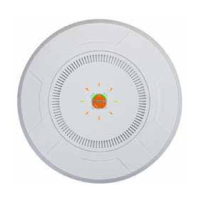Wireless Access Point
482 The Command Line Interface
reboot
The reboot command [MyAP(config)# reboot] is used to reboot the AP. If you
have unsaved changes, the command will notify you and give you a chance to
cancel the reboot.
reset
The reset command [MyAP(config)# reset] is used to reset all settings to their
default values then reboot the AP.
Command Description
<cr> Reboot the AP.
FORMAT:
reboot
delay Reboot the AP after a delay of 1 to 60 seconds.
FORMAT:
reboot delay [n]
Command Description
<cr> Reset all configuration parameters to their factory
default values.
FORMAT:
reset
The AP is rebooted automatically.
preserve-ip-
settings
Preserve all ethernet and VLAN settings and reset
all other configuration parameters to their factory
default values.
FORMAT:
reset preserve-ip-settings
The AP is rebooted automatically.

